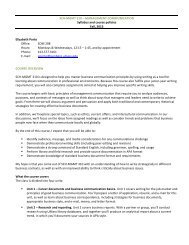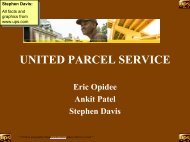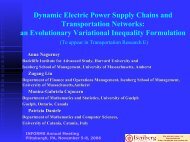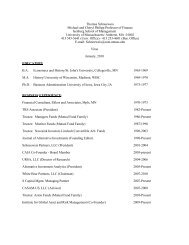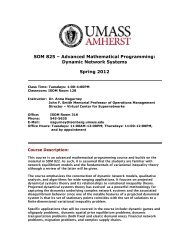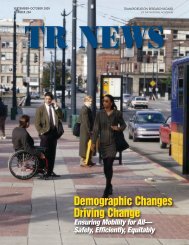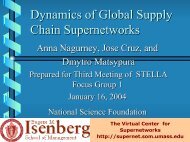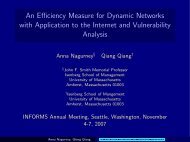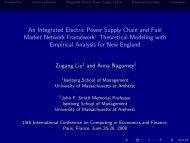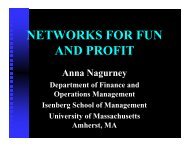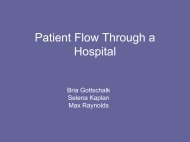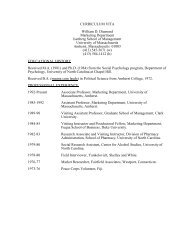Building The Isenberg Advantage Building The Isenberg Advantage
Building The Isenberg Advantage Building The Isenberg Advantage
Building The Isenberg Advantage Building The Isenberg Advantage
Create successful ePaper yourself
Turn your PDF publications into a flip-book with our unique Google optimized e-Paper software.
includes 18 hospitals around<br />
the United States. “One of our<br />
challenges has been to expand<br />
that growing national market with<br />
a very small sales force,” observed<br />
McDonald, a member of the<br />
firm’s board of directors. “That<br />
becomes more difficult owing to<br />
a 6 to 9-month sales cycle that<br />
requires approval of a hospital’s<br />
chief medical, legal, nursing,<br />
information, financial officers,<br />
and others,” noted Fortin, who is<br />
Patient.Edu’s CFO.<br />
To meet those challenges,<br />
Patient.Edu has forged marketing<br />
alliances with cable TV providers<br />
in hospitals, health care insurers,<br />
medical record specialists, and<br />
other firms that do business with<br />
hospitals<br />
and other<br />
health care<br />
providers. “In<br />
their study,<br />
the students<br />
emphasized<br />
that we—<br />
especially<br />
our web<br />
site—needed<br />
to market<br />
more directly<br />
to those<br />
players—that<br />
we were too focused on narrow<br />
hospital solutions,” explained<br />
Patient.Edu’s CEO, Steven<br />
Graziano. “Beyond that, they<br />
recommended that by redefining<br />
our markets in terms of wellness,<br />
we could expand them by 75%.”<br />
A prominent member of Patient.<br />
Edu’s board of directors insisted<br />
that the students’ study could<br />
have easily fetched competitive<br />
consulting fees, remarked Fortin.<br />
Added Paul McDonald, “<strong>The</strong><br />
students’ insights had a further<br />
advantage: unlike some<br />
consultants, the students brought<br />
no biases to the exercise.”<br />
<strong>The</strong> 2008-2009 <strong>Isenberg</strong><br />
Award Recipients honored at the<br />
<strong>Isenberg</strong> School’s 2008 Annual Awards<br />
Banquet in April, included two <strong>Isenberg</strong><br />
School students: MBA candidate Jason<br />
Gabisch (second row, far right) and<br />
Ph.D. candidate Xuan Huang (fi rst<br />
row, far left). Established by Eugene ’50<br />
and Ronnie <strong>Isenberg</strong> in 1994 to foster<br />
interdisciplinary integration among<br />
business, science, and engineering, the<br />
annual awards provide up to $10,000 for<br />
graduate students in the <strong>Isenberg</strong> School, the College of Engineering, the College of Natural Sciences<br />
and mathematics, and (for the fi rst time this year) the School of Nursing.<br />
Engineering Student Discovers<br />
Marketing Skills at the <strong>Isenberg</strong><br />
School; Wins Annual Technology<br />
Innovation Challenge<br />
Without question, <strong>Isenberg</strong> Scholar<br />
Brian Mullen has lived up to his <strong>Isenberg</strong><br />
Scholarship’s aim of fostering meaningful ties<br />
among business, science, and technology. In<br />
May, Mullen, a doctoral student in mechanical<br />
engineering, won the $50,000 grand prize in<br />
the UMass Amherst Technology Innovation<br />
Challenge (TIC)—with more than a little help<br />
from new-found friends in the <strong>Isenberg</strong> School’s<br />
marketing department and MBA program. In the<br />
competition—now in its third year—students,<br />
recent graduates, and faculty advisors submit<br />
technology-based business plans to a panel of<br />
judges, including technology entrepreneurs,<br />
consultants, and intellectual property specialists.<br />
Mullen’s winning entry, <strong>The</strong>rapeutic Systems,<br />
plans to market a light-weight deep- pressure<br />
vest developed on campus for the mentally ill,<br />
especially those with autism. Having come up<br />
short in the previous year’s TIC competition,<br />
Mullen knew that he had a promising product<br />
idea in search of a marketing plan. To make<br />
progress, he<br />
enrolled in<br />
two <strong>Isenberg</strong><br />
School MBA<br />
electives<br />
taught by<br />
marketing<br />
professor<br />
Brian Mullen and MBA candidate<br />
Chris Leidel.<br />
Tom<br />
Brashear—a<br />
marketing<br />
research course in the fall and a special topics<br />
course in marketing strategy in the spring. In the<br />
marketing research course, the class critiqued<br />
Mullen’s previous TIC executive summary and<br />
marketing surveys. “With their help, I learned<br />
how to ask more relevant questions and how<br />
to arrange those questions to yield optimal<br />
responses,” he recalls. “<strong>The</strong> course was eyeopening<br />
to me both as an engineer and an<br />
entrepreneur. I gained a greater appreciation for<br />
the customer’s perspective.”<br />
In the follow-up course, Mullen and MBA students<br />
Rebecca Faneuf ’08 and Stephen Burrows ’08<br />
focused on his project’s marketing plan. (Outside<br />
the course, 1 st -year MBA student, Christopher<br />
Leidel also helped Mullen with financials.)<br />
Following some preliminary marketing research,<br />
Mullen realized that he had previously been hasty<br />
in identifying his principal target market—parents<br />
of mentally challenged dependents. Better to<br />
focus on school and health care professionals<br />
like occupational therapists, teachers, and speech<br />
language therapists—all who have greater leverage<br />
over their institutions’ resources and purchases.<br />
“That insight allowed me to create a distribution<br />
plan and a viable marketing strategy,” explains<br />
Mullen. “You can’t attach financials without<br />
a marketing strategy.” With his plan in place,<br />
<strong>The</strong>rapeutic Systems went on to capture the<br />
$50,000 prize, most of which Mullen immediately<br />
invested in the development of an improved vest<br />
prototype. “Winning the challenge was not an<br />
end point,” notes Mullen. “It’s been a momentum<br />
builder in bringing the vest to market.”<br />
<strong>The</strong> Technology Innovation Challenge received<br />
financial support from the following <strong>Isenberg</strong><br />
School corporate friends and alumni: SABIC<br />
Innovative Plastics, Paul Carney ’82, and Eugene<br />
’50 and Ronnie <strong>Isenberg</strong>.<br />
11



